Partial History
Lord Simon de Manning, a former Lord of the Manor for Kevington, London and holder of the land which became Berry's Green, was a Grandson of Rudolph de Manning, Count Palatine, (who married Elgida, aunt to King Harold I of England), (Harold Harefoot); he was the royal Standard Bearer to King Richard the Lionheart, and carried the royal Standard to Jerusalem in 1190, during the First Crusade. In England, the forms Earl Palatine and Palatine Earldom are preferred.
On early maps, the area and Berry's Green Farm are each spelt as "Bury's Green".
On the junction of Jail Lane and Berry's Hill is a small wood, with a large World War II bomb crater. This may have been caused by a V-2 rocket as it is almost the same distance from Germany as the last known V-2, which was dropped in Kynaston Rd, Orpington. Many of the V-2s fell short of London towards the end of the war. There are also a number of smaller bomb craters scattered around the surrounding woodlands, due to its proximity to Biggin Hill airfield.
Berry's Green is home to The Old Jail, Biggin Hill, and Cherry Lodge Golf Course, which opened in 1968. The land there is approximately 600 ft. above sea level.
In the late 1960s and early 1970s, there was a sub-post office on the corner of Single Street and Jail Lane which sold provisions, such as bread, milk, sweets, and crisps. Mains sewerage was installed around 1973. Along with Biggin Hill and nearby Cudham it is the only place in Greater London to be part of the Tunbridge Wells postcode area (TN16).

Biggin Hill is a town in South East London, England, within the London Borough of Bromley. It is situated beyond London's contiguous built-up area in the Metropolitan green belt, 15.2 miles (24.5 km) south-southeast of Charing Cross. It is located adjacent to the Greater London boundary with Kent and Surrey. Prior to the creation of Greater London in 1965, it was in the historic and administrative county of Kent. At the 2011 Census, Biggin Hill had a population of 9,951.

Cudham is a village in Greater London, England, located within the London Borough of Bromley and beyond London's urban sprawl. It is located on the Greater London border with Kent, bordering the Sevenoaks District. Cudham lies south of Orpington and north west of Sevenoaks. It is located 15.9 miles (25.6 km) south-southeast of Charing Cross.

Keston is a village in Greater London, England, located within the London Borough of Bromley, Greater London. Prior to 1965 it was within the historic county of Kent. It is part suburban, part rural in nature and lies on the edge of Hayes Common, just beyond the London conurbation to the south of Bromley Common. It includes the small hamlet of Nash to the southwest. The northern, more suburban part of Keston is sometimes referred to as Keston Mark.
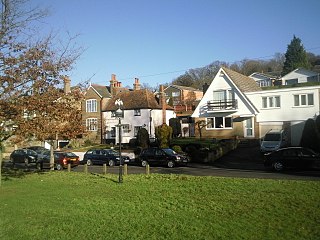
Pratt's Bottom is a village in Greater London, England, within the London Borough of Bromley and, prior to 1965, within the historic county of Kent. It is south of its parent parish of Orpington, lies about 100 metres above sea level and beyond London's urban sprawl.
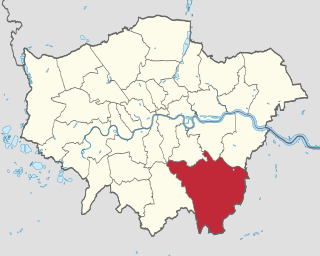
The London Borough of Bromley is the largest and southeasternmost of the London boroughs that make up Greater London, bordering the ceremonial county of Kent, which most of Bromley was part of before 1965. The borough's population is an estimated 332,336. It is named after Bromley, its principal town; other major towns are Penge, Hayes, West Wickham, Chislehurst, Beckenham and Orpington. The local authority is Bromley London Borough Council.

Downe, formerly Down, is a village in Greater London, England, located within the London Borough of Bromley but beyond London's contiguous urban area. Downe is 3.4 miles (5.5 km) south west of Orpington and 14.2 miles (22.9 km) south east of Charing Cross. Downe lies on a hill, and much of the centre of the village is unchanged; the former village school now acts as the village hall. The word Downe originates from the Anglo Saxon word dūn, latterly down, hence the South and North Downs. In April 1965, Downe and the remaining part of Orpington Urban District Council, was abolished, and transferred from the historic county of Kent and placed within the newly created London Borough of Bromley.
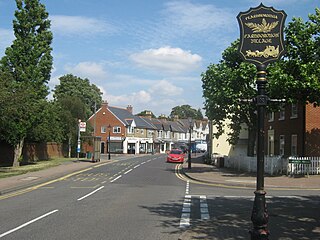
Farnborough is a village in south-eastern Greater London, England, and prior to 1965, in the historic county of Kent. Situated south of Locksbottom, west of Green Street Green, north of Downe and Hazelwood, and east of Keston, it is centred 13.4 miles (21.6 km) southeast of Charing Cross.
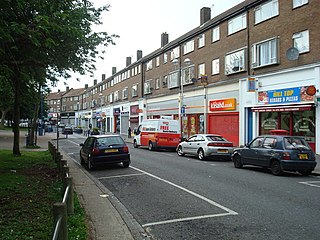
New Addington is a modern town in South London, England, within the London Borough of Croydon. It is located 5 miles south east of Croydon, south of Addington Village and north of Biggin Hill.

Tatsfield is a village and civil parish in the Tandridge District of Surrey, England. It is located 3.3 miles north west of Westerham and 3.9 miles north east of Oxted, and is adjacent to the Surrey border with both Greater London and Kent.

Green Street Green is an area in south-east London, located in the London Borough of Bromley and, prior to 1965, in the historic county of Kent. It is located south of Orpington, west of Chelsfield, north-west of Pratt's Bottom, north of Hazelwood, and south east of Farnborough.
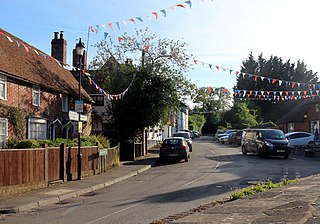
Chelsfield is an area in south-east London, England, within the London Borough of Bromley and, prior to 1965, in the historic county of Kent. It lies south of Goddington, west of Well Hill, north of Pratt's Bottom and east of Green Street Green. The area is split into two distinct areas – the historic 'village' section, and the newer development by the train station.

Aperfield is a hamlet and area in London, England, within the London Borough of Bromley, 16.2 miles (26 km) south-southeast of Charing Cross, and outside London's contiguous built-up area.
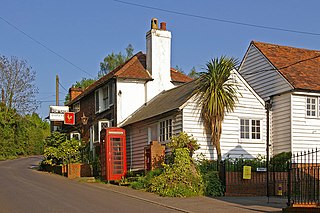
Well Hill is a small rural hamlet within the civil parish of Shoreham in the Sevenoaks District of Kent, England. It lies 3 miles south east of Orpington & 3.5 miles south of Swanley, adjacent to the Kent border with Greater London.
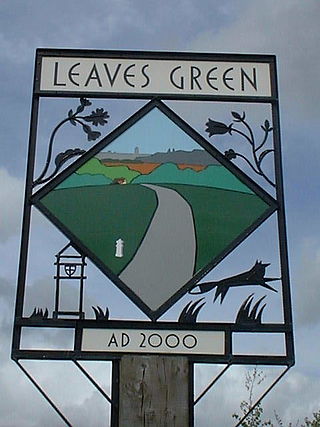
Leaves Green is a village in Greater London within the London Borough of Bromley.

Crofton is a suburb of Orpington in southeast London, England, located in the London Borough of Bromley in Greater London. Prior to 1965 it was within the historic county of Kent. It is about 13.6 miles (21.9 km) southeast of Charing Cross. It lies south of Petts Wood, west of Orpington and Broom Hill, north of Green Street Green and Farnborough, north-east of Locksbottom and east of Bromley Common.

Luxted is a hamlet in the London Borough of Bromley, located to the south of Downe. The area is rural, noted for its abundance of woods and grasslands. It is a part of the largest ward in Greater London, the Darwin (ward), which also includes Downe, Cudham, Leaves Green, Single Street, Berry's Green, and Westerham Hill.

Single Street is a hamlet in the London Borough of Bromley in Greater London, located between Luxted and Berry's Green, and centred around a street of the same name. The first record of a settlement under the name 'Single Street' is from an Ordnance Survey map in 1871, but its name is derived from sengel, an Old English word meaning 'burnt clearing'. It is part of the largest ward in Greater London, Darwin (ward), covering a rural area including Downe, Cudham, Leaves Green, Berry's Green, and Westerham Hill.
The Southern Heights Light Railway (SHLR) was to have been a speculative London area suburban electric railway between Orpington, Kent and Sanderstead, Surrey. It was authorised in 1928 under the Light Railways Act 1896, but ultimately not constructed. The engineer was to have been Colonel Holman Fred Stephens, heavily involved in the promotion of light railways.
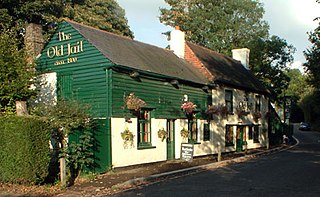
The Old Jail was a pub in Jail Lane, Biggin Hill, Westerham, Kent, in the London Borough of Bromley. At this time of writing,, it is permanently closed. Its future use is unknown. It is a Grade II listed building, dating back to the 18th century.
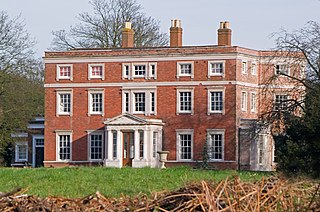
Kevington, sometimes spelt Kevingtown, is a rural hamlet in South East London, England, within the London Borough of Bromley. It is located north east of Orpington and south west of Swanley and is adjacent to the Greater London border with Kent.






















